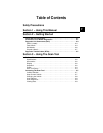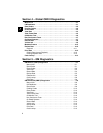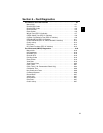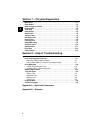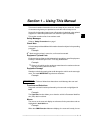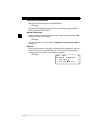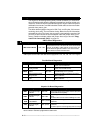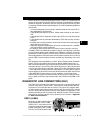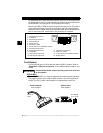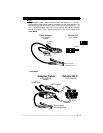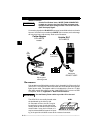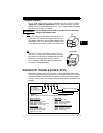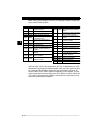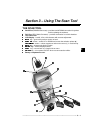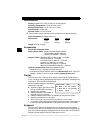
• • • • • • • • • • • • • • • • • • • • • • • • • • • • • • • • • • • • • • • • • • • • • • • • • • • • • • • • • 2 – 3
Getting Started
2
OBD II stands for On-Board Diagnostics version II. OBD II is a system that the
Society of Automotive Engineers (SAE) developed to standardize automotive
electronic diagnosis. Technicians now can use the same tool to test any OBD
II compliant vehicles without special adapters. The SAE established guidelines
that provide:
• a universal diagnostic test connector, called the data link connector (DLC),
with dedicated pin assignments.
• a standardized location for the DLC, visible under the dash on the driver’s
side.
• a standardized list of diagnostic trouble codes (DTCs) used by all manufac-
turers.
• a standardized list of parameter identification (PID) data used by all manu-
facturers.
• the ability of the vehicle system to record a freeze frame of the operating con-
ditions when a fault occurs.
• expanded diagnostic capabilities that records a code whenever a condition
occurs that effects vehicle emissions.
• the ability to clear stored codes from vehicle memory with the scan tool.
In addition, SAE has published hundreds of pages of text defining a standard
communications protocol that establishes the hardware, software, and circuit
parameters of OBD II systems. Unfortunately, vehicle manufacturers have dif-
ferent interpretations of this standard communications protocol. As a result, the
generic OBD II communications scheme used will vary, depending on the vehi-
cle.
SAE publishes recommendations, not laws, but the Environmental Protection
Agency (EPA) and California Air Resources Board (CARB) made many of
SAE’s recommendations legal requirements that vehicle manufacturers were
required to phase in over a three-year period. Beginning in 1994, vehicles with
a new engine management computer – about 10% of each manufacturers fleet
– were supposed to comply with OBD II standards. For 1995, OBD II systems
were to appear on about 40% of the new vehicles sold in the USA. Some of the
1994-1995 OBD II systems were not fully compliant, so the Government
granted waivers to give manufacturers time to fine-tune their systems. Begin-
ning in 1996, most of the new vehicles sold in the USA were fully OBD II com-
pliant.
DIAGNOSTIC LINK CONNECTORS (DLC)
The Data Link Connector (DLC) allows the scan tool to communicate with the
vehicle’s computer(s). Before OBD II, manufacturers used different data link
connectors to communicate with the vehicle. The proper DLC adapter cable
must be used to connect the tool to the vehicle. Also, the vehicle’s DLC may be
found in several different places and have many different configurations. The
following describes the DLCs used by Ford, GM and Chrysler. The DLC location
and types for domestic vehicles can be looked up in the charts in “Appendix
A - Data Link Connectors".
OBD II (J1962)
Beginning in 1996, vehicles sold in
the United States use the J1962
(OBD II) DLC, a term taken from a
physical and electrical specification
number assigned by SAE (J1962).
The DLC should be located under



